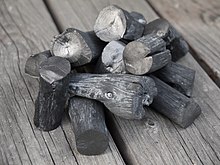|
Binchōtan
  Binchō-tan (Japanese: 備長炭, [biɲtɕoꜜːtaɴ]), also called white charcoal or binchō-zumi, is a type of high-quality charcoal traditionally used in Japanese cooking. Its use dates back to the Edo period when during the Genroku era, a craftsman named Bichū-ya Chōzaemon (備中屋 長左衛門) began to produce it in Tanabe, Wakayama. The typical raw material used to make binchō-tan in Japan is oak, specifically ubame oak, now the official tree of Wakayama Prefecture. Wakayama continues to be a major producer of high-quality charcoal, with the town of Minabe, Wakayama, producing more binchō-tan than any other town in Japan. Binchō-tan produced in Wakayama is referred to as Kishū binchō-tan (紀州備長炭), Kishū being the old name of Wakayama. White charcoal is made by pyrolysing wood in a kiln at approximately 240 °C (464 °F) for 120 hours, then raising the temperature to around 1,000 °C (1,830 °F). Once carbonised, the material is taken out and covered to cure in a damp mixture of earth, sand, and ash.[1] Binchō-tan is a type of hardwood charcoal which takes the natural shape of the wood that was used to make it. It is also harder than black charcoal, ringing with a metallic sound when struck. Due to its physical structure, binchō-tan takes on a whiter or even metallic appearance. Apart from being used for cooking, it has other benefits, such as absorption of odors[citation needed]. References
External linksWikimedia Commons has media related to Binchōtan.
|